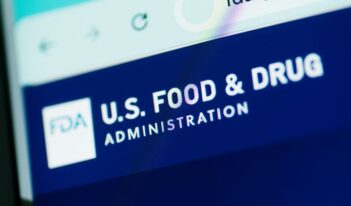
Scholar proposes an increased focus on children’s health in food, drug, and cosmetic regulation.
Children in the United States face risks from the products that the U.S. Food and Drug Administration (FDA) regulates, such as formula shortages, heavy metals in baby foods, and asbestos in children’s cosmetics.
Children have significant exposure to products regulated by FDA: over 3 million middle and high school students report using tobacco products, 45 percent of girls under the age of 5 use nail polish, and more than half of all infants consume infant formula within three months of birth. Yet, FDA lacks a comprehensive approach to children’s health across product types.
In a recent article, Marie Boyd, an associate professor at the University of South Carolina Joseph F. Rice School of Law, argues that FDA has fallen short in safeguarding and promoting children’s health. Identifying a need for FDA to comprehensively examine the impact of its regulation on children, Boyd suggests that FDA should create a central children’s health office to address issues impacting children across all FDA-regulated product categories, including food, drugs, cosmetics, and tobacco products.
Boyd describes children’s health as an “integral part” of FDA’s mission of protecting and promoting public health, given that children under the age of 18 comprise 22 percent of the United States population. Children also possess unique demographic features—they are more ethnically and racially diverse and more likely to live in poverty than adults in the United States.
Boyd characterizes children as a vulnerable population with distinct health risks. Boyd notes that children cannot be treated as “small adults” when regulating food and drugs because children are still developing, are more vulnerable to environmental hazards, and may react differently to products than adults. Children also lack the cognitive maturity required to consent to health research, making it more challenging for regulators to collect data about children’s health.
Beyond direct health risks, food and drug laws also have consequences on other aspects of children’s lives, Boyd explains. For example, approximately 2 million children are affected by parental use of opioids. Children of incarcerated parents, including those incarcerated for drug-related offenses, are more likely to experience physical and mental health conditions. In addition, over 55 million children were impacted by school closures during the early COVID-19 pandemic, with low-income, Black, and Hispanic students most likely to attend fully remote school.
Because of these challenges to protecting children’s health, Boyd urges FDA to ask “the child question.” Modeled after the feminist legal method of “asking the woman question,” the child question encourages regulators to consider how children have been left out of consideration in policies and evaluate comprehensively how food and drug laws impact children.
Boyd offers several examples of how FDA regulations impact children, suggesting that FDA could better promote children’s health by asking the child question. Taken together, Boyd argues, these examples demonstrate that FDA regulation “has failed to fully consider children’s needs to the detriment of children’s health.”
First, Boyd discusses children’s health as it relates to drugs, biologics, and devices. Boyd explains that the scarcity of pediatric clinical research data causes the widespread use of “off-label” medications on children and limits information on dosing, effectiveness, and side effects for pediatric patients. This off-label use can expose children to unforeseen adverse outcomes or deprive them of the intended therapeutic benefits. A lack of health data can similarly put children at significant risk of pediatric drug shortages, Boyd notes.
Boyd also argues that FDA decision-making about the costs and benefits of drugs, biologics, and devices fails to consider impacts on children’s health adequately, citing opioid and COVID-19 vaccine regulation as examples.
Second, Boyd argues that FDA has failed to consider children’s needs fully with its tobacco product regulation, pointing to children’s e-cigarette use as an example of the impact of regulatory delays. Boyd suggests that FDA’s regulation of e-cigarettes has been hampered by administrative delays, as youth e-cigarette use has continued to expose millions of children to significant health risks, both immediately and into adulthood.
Third, Boyd contends that FDA’s regulation of food products has also failed to consider children’s health fully. Boyd argues that structural barriers within FDA likely contributed to a 2022 infant formula shortage in which the national out-of-stock rate reached 74 percent after contaminated formula was recalled. Boyd also suggests that FDA’s attempts to limit heavy metals in baby foods may be too narrow in scope—failing to address certain potential contaminants in baby food products—as well as too lax with respect to maximum contaminant levels.
Finally, Boyd cites reports of asbestos contamination in cosmetic products marketed to children as an example of how FDA’s cosmetic regulation could benefit from an increased focus on children’s health.
To address FDA’s inadequate focus on children’s health, Boyd contends that FDA should create a children’s health office that works across product categories “to assess the impact FDA’s regulatory actions have on children” and to prevent children’s from being left out of consideration.
Boyd notes that there are already offices at FDA focused on how different FDA-regulated products impact specific populations—such as the Office of Women’s Health and the Office of Minority Health and Health Equity.
Boyd proposes that FDA create a child-focused version, that would focus on children’s health “outside of the silos of a specific product center or regulatory focus,” supplementing but not supplanting FDA’s existing child-related work. Boyd suggests that a centralized office of children’s health could reduce the fragmentation of FDA’s child-related work by integrating efforts that cut across or blur the lines between different categories of FDA-regulated products.
FDA’s failure to increase its focus on children’s health issues, Boyd warns, could jeopardize its mission of advancing public health for children.



